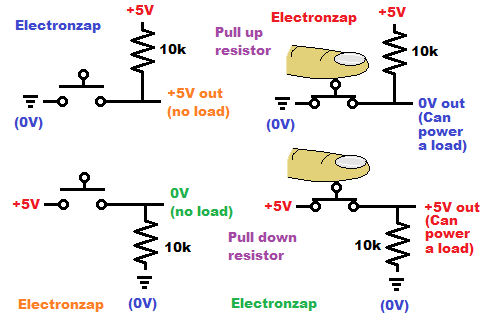Table of Contents
Many electronic input terminals are sensitive to stray voltages when they are floating (not connected to a voltage). Voltage signal based inputs don’t let current flow through them. Which means that an undesired voltage can easily build up on them from stray electromagnetic activity in the air.

A relatively high value pull up resistor can be used to connect the input to the positive supply in order to keep the output high instead of floating.
Or, a relatively high value (pull down) resistor can be connected between the output and negative supply voltage to keep the output low instead of floating.
A switch of some kind is generally also connected to the output, but heading to the opposite supply voltage. When you want that other voltage, you simply close the switch so that it is shorted to that supply voltage. The pull up or down resistor will pass some current, but that won’t affect the voltage that is output.
Video below goes live at 6am CST 30 April 2023
Good topics to check out next:
To support this site, check out the following links:
- Check out my YouTube videos! https://www.youtube.com/c/Electronzap/videos
- Products I used in my videos or otherwise think look like a good buy. As an Amazon associate, I earn from qualifying purchases. https://www.amazon.com/shop/electronzapdotcom
- Information on this site is not guaranteed to be accurate. Always consult the manufacturer info/datasheet of parts you use. Research the proper safety precautions for everything you do.
- Electronzap is a participant in the Amazon Services LLC Associates Program, an affiliate advertising program designed to provide a means for sites to earn advertising fees by advertising and linking to amazon.com.